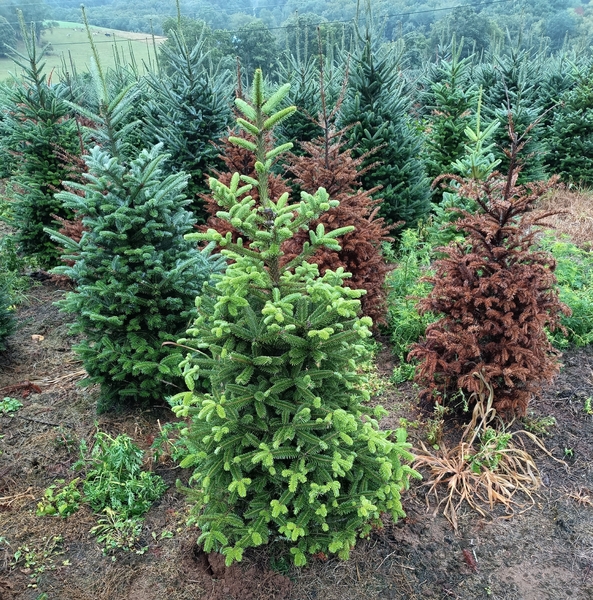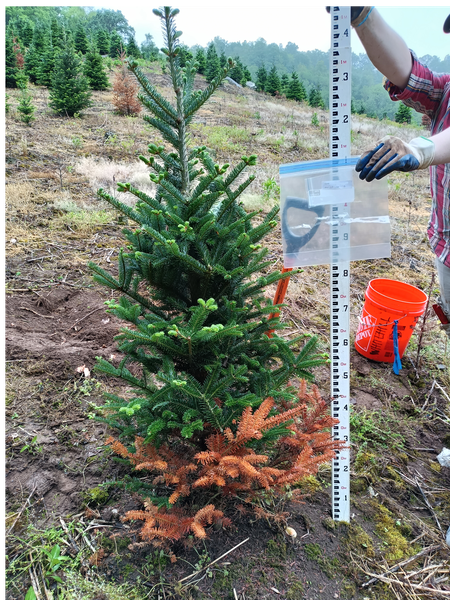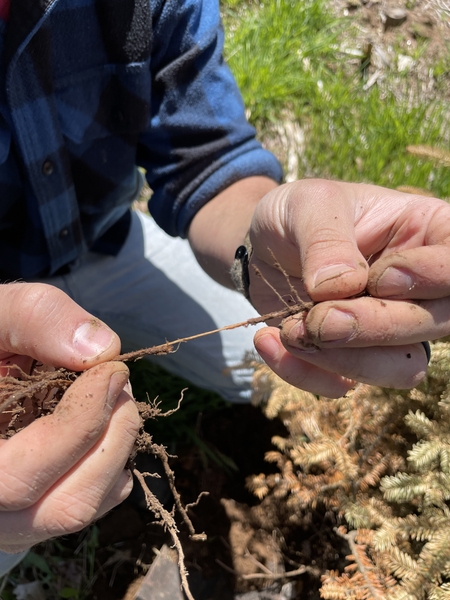Introduction
Phytophthora root rot (PRR), caused by several Phytophthora species, has been associated with significant damage to Fraser fir since the 1960s. Phytophthora is a fungus-like oomycete that inhabits the soil and infects many woody plants through the roots. With the production of chlamydospores as long-term survival structures, Phytophthora can lie dormant in the soil for several years, waiting for a susceptible host such as Fraser fir and the right environmental conditions, including warm soil temperatures (above 54°F) and saturated soils to infect plant roots. Due to this persistence, once Phytophthora becomes established on a site, the area is typically no longer able to be used for non-grafted Fraser fir production, making this disease one of the major limiting factors for Christmas tree growers.
Symptoms of Phytophthora root rot
The above-ground symptoms of Phytophthora root rot on Fraser fir include yellow-green needles, wilting, slow growth, delayed bud break, dead branches, and tree death (Figure 1). The needles remain on dead branches and turn cinnamon brown. Roots of affected trees are also cinnamon-colored to black and lack white growing tips. The outer surface of the root can be pulled away from the inner core, also called 'root sloughing,' and fine, feeder roots are often absent. Cutting into the bark of the trunk of the tree below symptomatic branches may reveal butterscotch colored wood (Figure 2). Often these symptoms are initially present on only one side of the tree or on lower branches since Phytophthora first infects a root and grows toward the trunk on that side, often described as PRR ‘flagging’ (Figure 3). Eventually the entire tree will die. Infected trees are usually found grouped together in a field or bed following above-ground water drainage. Unfortunately, a tree may be infected with Phytophthora months before the above-ground symptoms begin to develop.
Tree symptoms can have other causes than disease such as white grubs, transplant shock, fertilizer burn, and other problems. To determine if yellowing or dying seedlings or trees have Phytophthora root rot, contact your local N.C. Cooperative Extension agent to collect root samples. These root samples should be sent to the Plant Disease and Insect Clinic (PDIC) at NC State in Raleigh to determine if the pathogen is present.

Figure 1: Typical PRR “hotspot” with the frontmost tree showing the beginnings of PRR symptoms with PRR-killed Fraser fir in the behind it. The bright lime-green foliage is often the first symptom seen in Fraser fir to PRR, though may also be due to nutrient deficiency. Identification of other PRR symptoms present can help to confirm PRR diagnosis.
Caleb Cothron

Figure 3: Fraser fir beginning to show PRR symptoms. Most apparent is the “flagging” of the lower branch on one side of the tree. If you were to peel back the bark at the trunk at the orange branch you would see something like in Figure 2. Another PRR symptom present here is the delayed budbreak of this tree relative to other trees in the plot.
Caleb Cothron
Causal Organism and Disease Spread
Phytophthora root rot is caused by several species of Phytophthora. In western North Carolina, the most prevalent and devastating species is P. cinnamomi. Often called a water mold, P. cinnamomi produces spores in response to near-saturated soils and favorable conditions. Phytophthora may remain dormant in the soil for many years as mycelium (hyphae threads) in infected root pieces or as chlamydospores, a thick-walled resting spore. During the growing season when soils are warm and wet, mycelium or chlamydospores produce sporangia. These lemon-shaped structures cause new infestation either by germinating and colonizing roots, or by releasing zoospores that have formed inside each sporangium. Though primarily spread through water movement, zoospores can swim short distances by means of flagella and are capable of directing their movement towards the roots of host plants based on chemical attraction.
The pathogen can be introduced into a field by contaminated equipment, with infected nursery stock, or with water runoff from nearby infested sites. Of these, transplanting infected seedlings represents a major contribution to disease incidence. Growers bringing in transplants from other states may also introduce new Phytophthora species to western North Carolina as recent studies have identified.
Reducing the Risk
Controlling Phytophthora root rot requires an Integrated Pest Management approach. No single control strategy will prevent or control this disease. As with most plant diseases, the best control is through healthy seedlings and transplants, and proper site selection. If trees become infected with Phytophthora, management should change to practices that reduce the spread of the disease and minimize financial loss. Each step outlined in this note will help reduce the risk of getting and spreading this disease.
FIRST STEP: CLEAN SEEDLINGS / TRANSPLANTS
Phytophthora spreads quickly in seed beds or transplant beds because the seedling roots grow closely together, allowing the Phytophthora to grow from one tree to another. Phytophthora can be carried to the field on or in infected transplants. Unfortunately, a transplant can appear healthy for several months after it has been infected.
To ensure the cleanest transplants possible, follow these steps:
- Select the site for seedling or transplant beds where there has never been an incidence of Phytophthora root rot. Beds should be located in an area where they will not be flooded, where water will not drain through the beds, and where soil is not tight or has a high clay content.
- Prepare raised beds that are 6-8 inches in height to increase water drainage. Soil should be carefully prepared to break up all clods and allow plant material to decay.
- Fumigate the soil before sowing or planting with methyl bromide or some other labeled soil fumigant. This will reduce the amount of fungus and Phytophthora in the soil. For any treatment, label directions must be followed.
- Irrigate seed beds and transplants with well water. Water from farm ponds, creeks, and rivers may be contaminated with Phytophthora spores which could infect plants.
- Use Subdue MAXX fungicide in the spring and fall to prevent disease development. Apply 21⁄2 pints Subdue MAXX in at least 50 gallons of water per acre in seed beds and 5 pints Subdue MAXX in at least 50 gallons of water per acre in transplant beds. Consider rotating with another fungicide such as Aliette. Aliette should be applied to the foliage until run-off using 5 pounds of product per 100 gallons of water. (Note: Waiting to use Subdue MAXX until after trees start dying from Phytophthora will only give you a false sense of security. Subdue MAXX will protect living tissue as long as the dosage remains in the plant. However, when it wears off, the plant is again at risk. Subdue MAXX will not eliminate Phytophthora from the soil or from dead roots. Once the trees are moved to the field and are no longer being treated with Subdue MAXX, Phytophthora will become active again and trees may start to die).
- Only purchase seedlings and transplants from a reputable dealer. Don't purchase plants from beds that have dead or dying plants.
- Do not set transplants if roots are discolored and exhibit 'root sloughing' [Figure 4].
If Phytophthora is diagnosed and diseased seedlings are isolated to one corner or section of a transplant bed, you may still be able to use plants in the rest of the bed or adjacent beds. Contact your local N.C. Cooperative Extension agent to help you determine if it is safe to use plants from unaffected parts of a bed. Remember that an apparently green and healthy plant may be infected.
SECOND STEP: FIELD SITE SELECTION AND FIELD CLEARING
Soils may only need to be saturated for several hours for Phytophthora to infect roots. Fraser fir should only be planted in fields where water drains quickly down through the soil as well as drains quickly off the field. Examine a potential field site for any areas where water collects or drains. Are there wet weather springs? Does a culvert drain onto the field? Be sure when placing field roads that problems with water drainage aren't created. It may be necessary to go to a site during a heavy rain to observe water drainage.
Examine the soil at potential field sites to determine how easily water will drain down through the soil profile. A high clay content decreases water flow and holds water longer. Not only is clay in the topsoil a potential problem but also clay in the subsoil. Hardpans and shallow soils will slow water flow. Compacted soils also hold more water and slow water flow down through the soil. In the largest field study of Fraser fir of over 250 sites conducted by NC State University, clay content of the subsoil and shallow soil depth were the two most important site factors to determining Phytophthora incidence.
If fields are to be cleared of brush with heavy equipment, special care should be taken to reduce soil compaction and the loss of topsoil since this will increase the risk of Phytophthora root rot. Do not use heavy equipment when the soil is wet. Do not push topsoil off the site. Sow a cover crop in the field to help repair soil structure after clearing before trees are set.
Phytophthora can infect several hundred species of plants including red bud, dogwood, rhododendrons, mountain laurel, white pines, and honeysuckle. There is a slight possibility that woodlands cleared for Fraser fir already have Phytophthora in the soil. Also, growers setting Fraser fir in old apple orchards or where apple trees were growing in old pastures have had problems with Phytophthora. Several species of Phytophthora are associated with apple roots and appear to infect Frasers planted nearby. Grass and clover are not hosts and Phytophthora are not likely be present in old pastures.
THIRD STEP: KEEPING ROOTS HEALTHY
Phytophthora is attracted to roots of a susceptible hosts. A healthy, robust root system may help delay the inevitable death of the Fraser following Phytophthora exposure. The following measures will improve root health:
- Do not set Fraser fir transplants deeper than 1 inch above the root collar. Forcing a large root system into a small planting hole will cause the roots to grow in the shape of a J, weakening root growth. Avoid excessive root pruning when planting.
- Spread fertilizer evenly. Piles of fertilizer on the ground will damage roots growing directly underneath.
- Limit use of Simazine. High rates of Simazine will damage roots.
- Allow ground covers to grow between trees to keep the soil cool. Fraser fir roots will grow closer to the surface of the soil where there is more oxygen and less water. Contact your local N.C. Cooperative Extension agent to learn more about ground cover management through the use of suppressive rates of post-emergent herbicides.
FOURTH STEP: WHAT TO DO IF PHYTOPHTHORA DEVELOPS
Even with care, Phytophthora root rot can develop, especially after heavy rainfall or flooded conditions. The following steps may reduce disease spread and tree loss:
Quarantine areas of the field where trees are dying with Phytophthora. Soil from these infested areas can carry the Phytophthora spores. When working in trees, visit infected areas last. Don't carry mud on boots or equipment to areas of the field where trees are not dying. Wash soil off of boots or equipment with water and chlorine bleach when moving from contaminated to clean farms or use disposable plastic boot coverings when in Phytophthora contaminated sites. Keep a ground cover on quarantined areas to reduce the spread of soil infested with Phytophthora to clean locations.
- PRR killed trees should be removed by cutting the aboveground portion of the tree and carefully disposing of the tree away from the field. Do not remove the stump as it will greatly disturb the soil, distributing Phytophthora in the process.
- Water that drains through a field should be diverted, if possible, to reduce disease spread.
- Early harvesting near affected areas may reduce financial losses. Selling trees when they are smaller than you intended is better than leaving those trees to die.
- Trees immediately surrounding diseased trees may be treated in the field with Subdue MAXX and/or Aliette/Fosphite. Apply these products in the early spring and again in late summer. Application should be made 1 to 3 days before a predicted rain. Never apply Subdue MAXX to fir growing on bottom lands or poorly drained soils, or near surface water since it may contaminate streams. This treatment is expensive and may not be cost effective if the trees are more than a year from harvest.
- Do not replant Fraser fir on sites where Frasers have died because of Phytophthora root rot. Alternative species may be used including Colorado blue spruce, and Norway spruce. White pines, Turkish and Trojan firs may also be grown where Frasers have been killed by Phytophthora root rot. However, as they are not 100% resistant, if Phytophthora populations are high or the site is poor, they may die, too. Fraser fir grafted onto the roots of completely resistant fir species like Momi fir can survive in areas where Fraser fir has died.
The best way to manage Phytophthora root rot is to never get it. Disease-free seedlings and transplants, and site selection and sanitation continue to be the mainstays of Phytophthora root rot management.
Publication date: Jan. 1, 2004
Revised: Jan. 10, 2019
Recommendations for the use of agricultural chemicals are included in this publication as a convenience to the reader. The use of brand names and any mention or listing of commercial products or services in this publication does not imply endorsement by NC State University or N.C. A&T State University nor discrimination against similar products or services not mentioned. Individuals who use agricultural chemicals are responsible for ensuring that the intended use complies with current regulations and conforms to the product label. Be sure to obtain current information about usage regulations and examine a current product label before applying any chemical. For assistance, contact your local N.C. Cooperative Extension county center.
N.C. Cooperative Extension prohibits discrimination and harassment regardless of age, color, disability, family and marital status, gender identity, national origin, political beliefs, race, religion, sex (including pregnancy), sexual orientation and veteran status.


